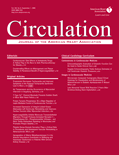 Journal cover | |
| Discipline | Cardiology, cardiovascular medicine |
|---|---|
| Language | English |
| Edited by | Joseph A. Hill |
| Publication details | |
| History | 1950–present |
| Publisher | Lippincott Williams & Wilkins (United States) |
| Frequency | Weekly |
| Delayed (after 12-month) | |
| 38.6 [1] [2] (2024) | |
| Standard abbreviations | |
| ISO 4 | Circulation |
| Indexing | |
| ISSN | 0009-7322 (print) 1524-4539 (web) |
| OCLC no. | 1554748 |
| Links | |
Circulation is a scientific journal published by Lippincott Williams & Wilkins for the American Heart Association. The journal publishes articles related to research in and the practice of cardiovascular diseases, including observational studies, clinical trials, epidemiology, health services and outcomes studies, and advances in applied (translational) and basic research. Its 2021 impact factor is 39.918, ranking it first among journals in the Cardiac and Cardiovascular Systems category and first in the Peripheral Vascular Disease category. [3] Articles become open access after a 12-month embargo period.
Contents
2008 saw the appearance of six subspecialty journals. The first edition of Circulation: Arrhythmia and Electrophysiology appeared in April 2008, [4] followed by an edition dedicated to heart failure in May titled Circulation: Heart Failure. [5] The remaining four journals launched once per month from July through October 2008. In order of release they were, Circulation: Cardiovascular Imaging , [6] Circulation: Cardiovascular Interventions , [7] Circulation: Cardiovascular Quality and Outcomes, [8] and Circulation: Cardiovascular Genetics (now published as Circulation: Genomic and Precision Medicine since January 2018). [9]